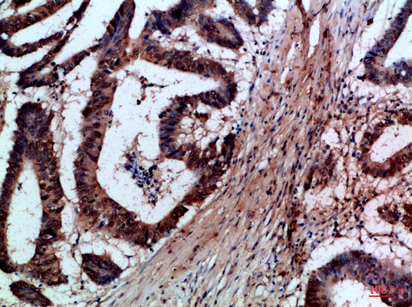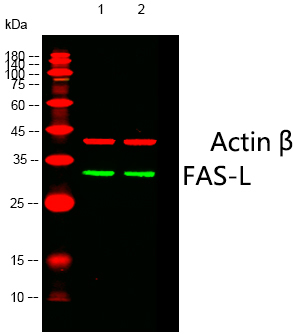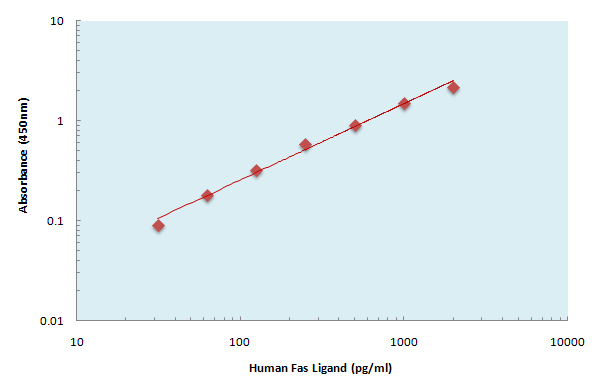
Catalog: KA3256C
Size
Price
Status
Qty.
96well
$330.00
In stock
0
Add to cart


Collected


Collect
Main Information
Reactivity
Human, Mouse
Applications
ELISA
Conjugate/Modification
Unmodified
Detailed Information
Storage
2-8°C/6 months,Ship by ice bag
Modification
Unmodified
Detection Method
Colorimetric
Related Products
Antigen&Target Information
Gene Name:
FASLG
show all
Other Name:
Tumor necrosis factor ligand superfamily member 6 ;
Apoptosis antigen ligand ;
APTL ;
CD95 ligand ;
CD95-L ;
Fas antigen ligand ;
Fas ligand ;
FasL ;
CD antigen CD178 ;
[Cleaved into: Tumor necrosis factor ligand superfamily member 6, membrane form ;
Tumor necrosis factor ligand superfamily member 6, soluble form ;
Receptor-binding FasL ectodomain ;
Soluble Fas ligand ;
sFasL ;
ADAM10-processed FasL form ;
APL ;
FasL intracellular domain ;
FasL ICD ;
SPPL2A-processed FasL form ;
SPA ;
]
Apoptosis antigen ligand ;
APTL ;
CD95 ligand ;
CD95-L ;
Fas antigen ligand ;
Fas ligand ;
FasL ;
CD antigen CD178 ;
[Cleaved into: Tumor necrosis factor ligand superfamily member 6, membrane form ;
Tumor necrosis factor ligand superfamily member 6, soluble form ;
Receptor-binding FasL ectodomain ;
Soluble Fas ligand ;
sFasL ;
ADAM10-processed FasL form ;
APL ;
FasL intracellular domain ;
FasL ICD ;
SPPL2A-processed FasL form ;
SPA ;
]
show all
Background:
disease:Defects in FASLG are the cause of autoimmune lymphoproliferative syndrome type 1B (ALPS1B) [MIM:601859]; also known as Canale-Smith syndrome (CSS). ALPS is a childhood syndrome involving hemolytic anemia and thrombocytopenia with massive lymphadenopathy and splenomegaly.,function:Cytokine that binds to TNFRSF6/FAS, a receptor that transduces the apoptotic signal into cells. May be involved in cytotoxic T-cell mediated apoptosis and in T-cell development. TNFRSF6/FAS-mediated apoptosis may have a role in the induction of peripheral tolerance, in the antigen-stimulated suicide of mature T-cells, or both. Binding to the decoy receptor TNFRSF6B/DcR3 modulates its effects.,online information:FAS-ligand entry,online information:FASLG mutation db,PTM:N-glycosylated.,PTM:The soluble form derives from the membrane form by proteolytic processing.,similarity:Belongs to the tumor necrosis factor family.,subcellular location:May be released into the extracellular fluid, probably by cleavage form the cell surface.,subunit:Homotrimer.,
show all
Function:
eye development, response to molecule of bacterial origin, apoptosis, induction of apoptosis, inflammatory cell apoptosis, immune response, cell-cell signaling, sensory organ development, cell death, induction of apoptosis by extracellular signals, activation of pro-apoptotic gene products, response to bacterium, positive regulation of signal transduction, response to organic substance, developmental programmed cell death, regulation of protein kinase cascade, positive regulation of cell communication, positive regulation of protein kinase cascade, regulation of necrotic cell death, positive regulation of necrotic cell death, regulation of cell death, positive regulation of cell death,programmed cell death, induction of programmed cell death, death, response to lipopolysaccharide, regulation of apoptosis, positive regulation of apoptosis, regulation of programmed cell death, positive regulation of programmed cell death, regulation of I-kappaB kinase/NF-kappaB cascade, positive regulation of I-kappaB kinase/NF-kappaB cascade, retinal cell programmed cell death, eye morphogenesis, regulation of necroptosis, positive regulation of necroptosis, induction of necroptosis, induction of necroptosis of activated-T cells, induction of necroptosis by extracellular signals, necrotic cell death,
show all
Cellular Localization:
Cell membrane ; Single-pass type II membrane protein . Cytoplasmic vesicle lumen . Lysosome lumen . Is internalized into multivesicular bodies of secretory lysosomes after phosphorylation by FGR and monoubiquitination (PubMed:17164290). Colocalizes with the SPPL2A protease at the cell membrane (PubMed:17557115). .; [Tumor necrosis factor ligand superfamily member 6, soluble form]: Secreted . May be released into the extracellular fluid by cleavage from the cell surface. .; [FasL intracellular domain]: Nucleus . The FasL ICD cytoplasmic form is translocated into the nucleus. .
show all
Signaling Pathway
Cellular Processes >> Cell growth and death >> Apoptosis
Cellular Processes >> Cell growth and death >> Necroptosis
Organismal Systems >> Immune system >> Natural killer cell mediated cytotoxicity
Organismal Systems >> Nervous system >> Neurotrophin signaling pathway
Human Diseases >> Cancer: overview >> Pathways in cancer
Human Diseases >> Immune disease >> Autoimmune thyroid disease
Human Diseases >> Immune disease >> Allograft rejection
Human Diseases >> Immune disease >> Graft-versus-host disease
Human Diseases >> Neurodegenerative disease >> Pathways of neurodegeneration - multiple diseases
Environmental Information Processing >> Signal transduction >> MAPK signaling pathway
Environmental Information Processing >> Signal transduction >> Ras signaling pathway
Environmental Information Processing >> Signal transduction >> FoxO signaling pathway
Environmental Information Processing >> Signal transduction >> PI3K-Akt signaling pathway
Environmental Information Processing >> Signaling molecules and interaction >> Cytokine-cytokine receptor interaction
Reference Citation({{totalcount}})
Catalog: KA3256C
Size
Price
Status
Qty.
96well
$330.00
In stock
0
Add to cart


Collected


Collect
Recently Viewed Products
Clear allPRODUCTS
CUSTOMIZED
ABOUT US
Toggle night Mode
{{pinfoXq.title || ''}}
Catalog: {{pinfoXq.catalog || ''}}
Filter:
All
{{item.name}}
{{pinfo.title}}
-{{pinfo.catalog}}
Main Information
Target
{{pinfo.target}}
Reactivity
{{pinfo.react}}
Applications
{{pinfo.applicat}}
Conjugate/Modification
{{pinfo.coupling}}/{{pinfo.modific}}
MW (kDa)
{{pinfo.mwcalc}}
Host Species
{{pinfo.hostspec}}
Isotype
{{pinfo.isotype}}
Product {{index}}/{{pcount}}
Prev
Next
{{pvTitle}}
Scroll wheel zooms the picture
{{pvDescr}}



















